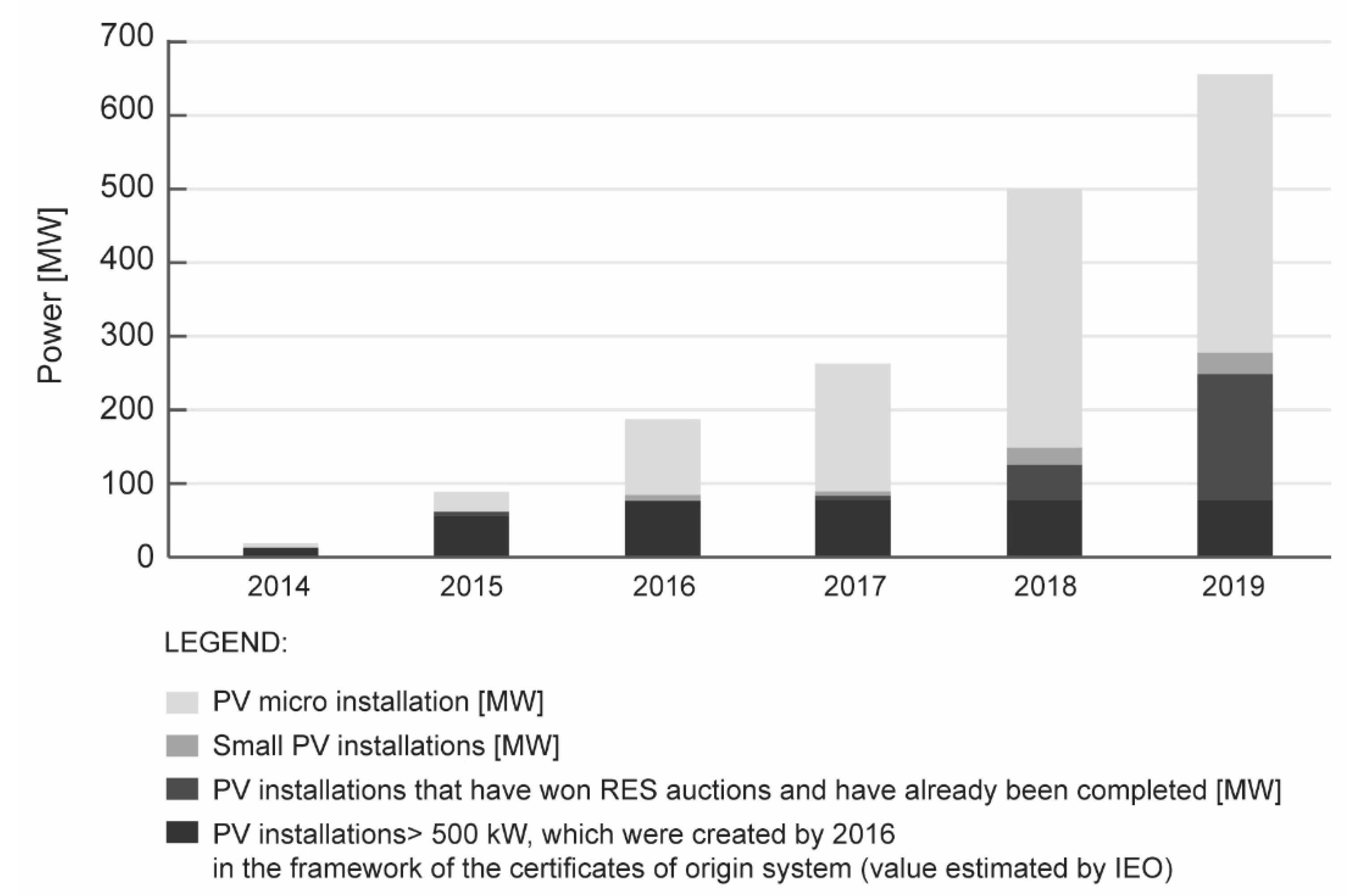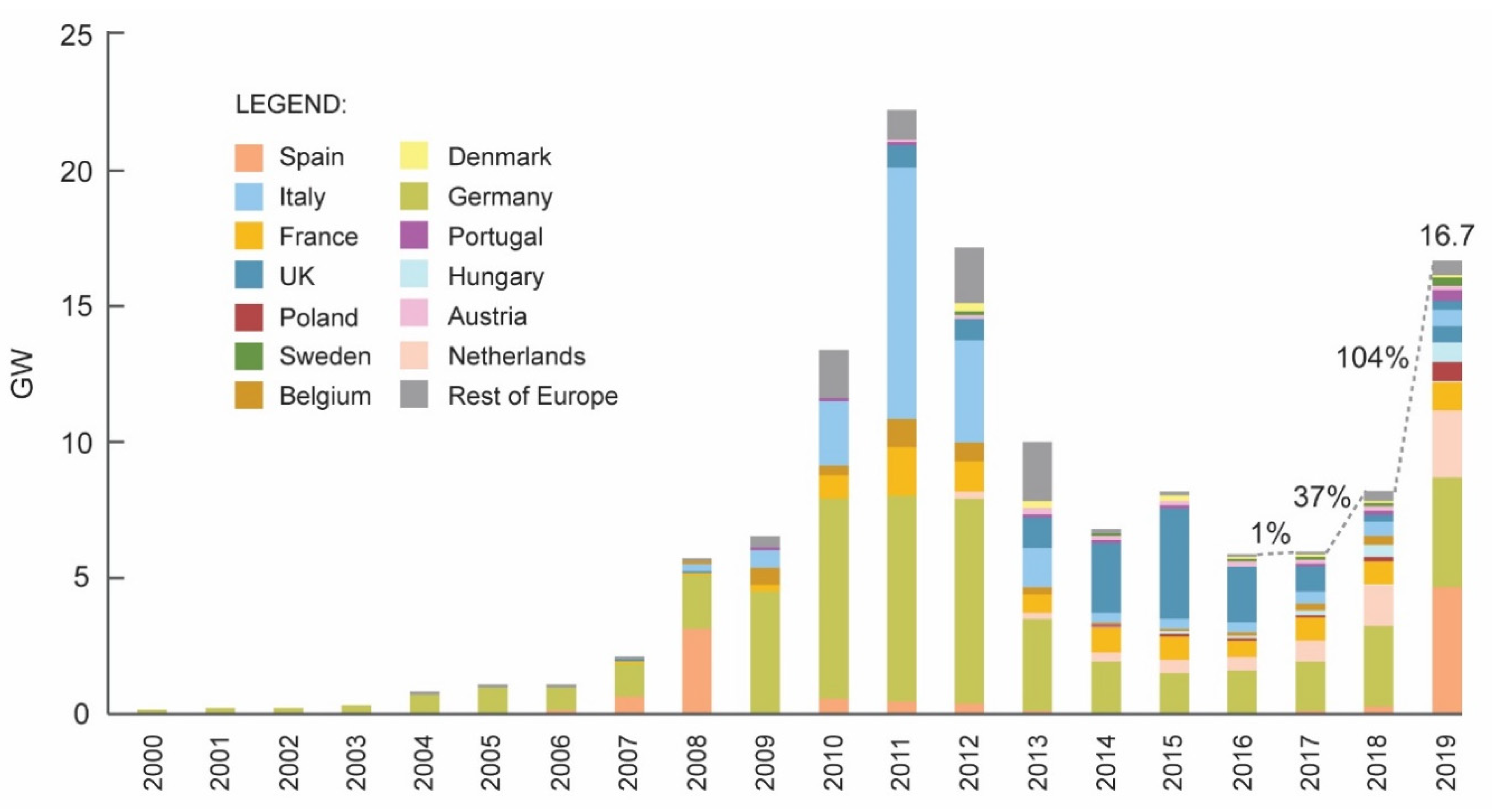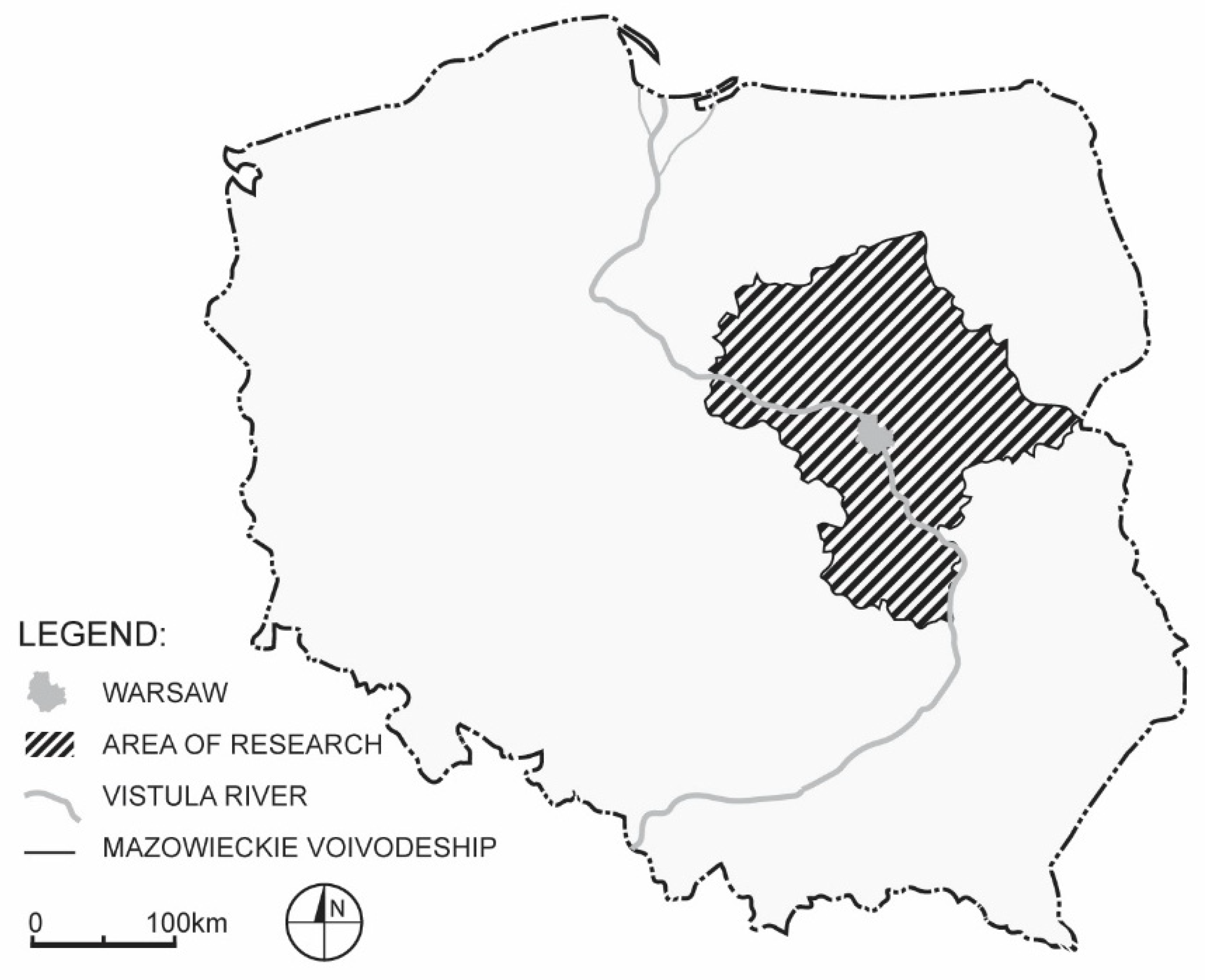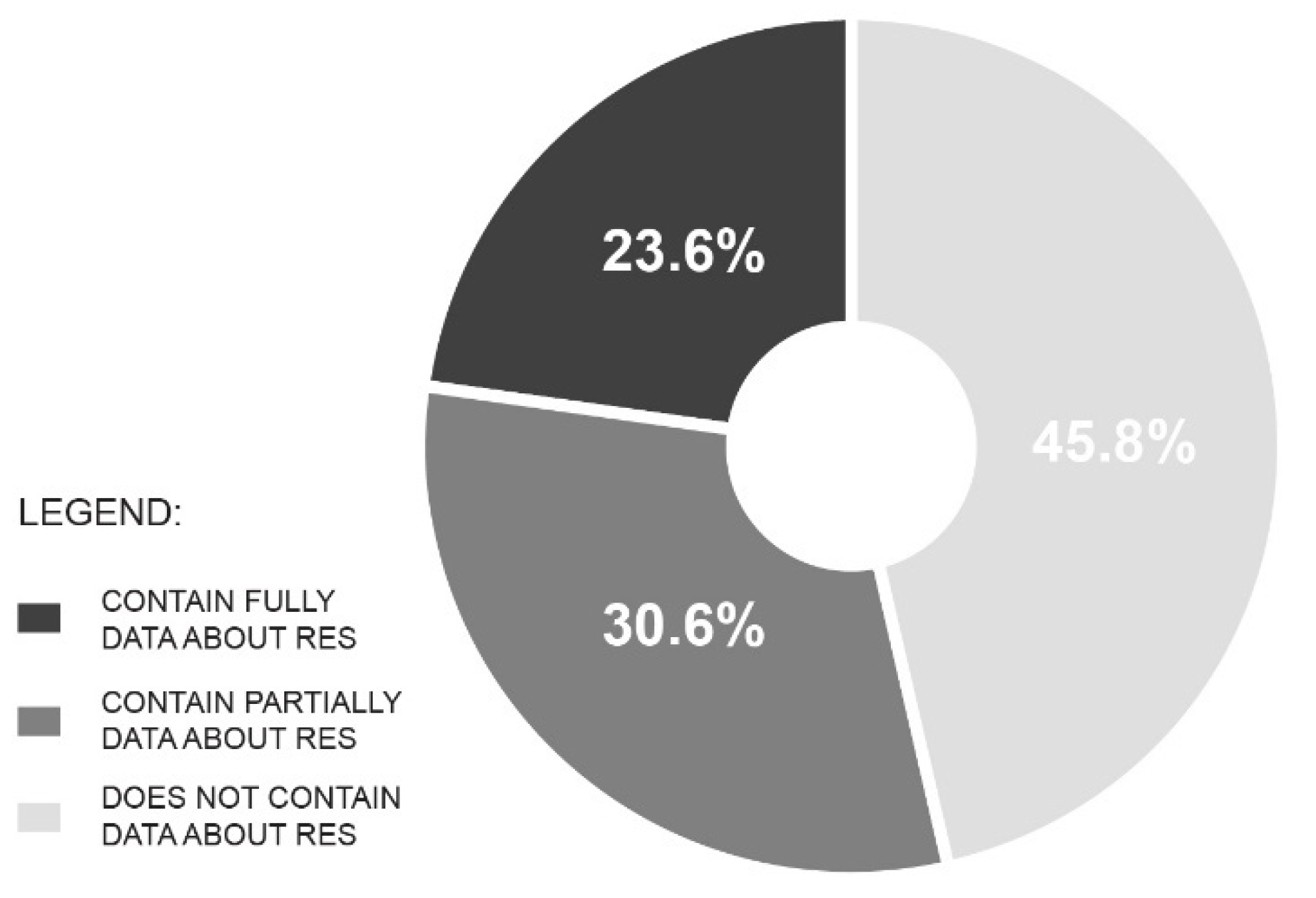Local Spatial Plans as Determinants of Household Investment in Renewable Energy: Case Studies from Selected Polish and European Communes
Abstract
:1. Introduction
2. Materials and Methods
2.1. Renewable Energy Sources Included in the Research
2.2. Selection of Countries for Qualitative Analysis and Its Scope
2.3. Methodology of the Polish Local Spatial Plans Analysis and Materials Used
- Does the plan contain any mention of RES?
- Does the plan allow the use of RES?
- Does the plan prohibit the use of RES?
- Does the plan introduce any restrictions for RES?
- What type of electricity supply is included in the plan?
- What way of heating buildings is included in the plan?
3. Results and Discussion
3.1. Planning Regulations Concerning Investments in Renewable Energy Sources for Households in Selected European Countries
3.2. The Results of Research on Polish Local Plans in Terms of Arrangements for Renewable Energy Investments for Households
- Plans that do not have any provisions on RES
- Plans that mention RES only in the context of heat energy
- Plans that fully address the implementation of RES
3.3. Threats and Opportunities for the Implementation of Local Spatial Plan Regulations on RES
4. Conclusions
Author Contributions
Funding
Institutional Review Board Statement
Informed Consent Statement
Data Availability Statement
Conflicts of Interest
References
- Energy Consumption and Use by Households. Available online: https://ec.europa.eu/eurostat/web/products-eurostat-news/-/DDN-20200626-1 (accessed on 20 September 2021).
- McCollum, D.L.; Echeverri, L.G.; Busch, S.; Pachauri, S.; Parkinson, S.; Rogelj, J.; Krey, V.; Minx, J.C.; Nilsson, M.; Stevance, A.-S.; et al. Connecting the Sustainable Development Goals by Their Energy Inter-Linkages. Environ. Res. Lett. 2018, 13, 033006. [Google Scholar] [CrossRef]
- Fuso Nerini, F.; Tomei, J.; To, L.S.; Bisaga, I.; Parikh, P.; Black, M.; Borrion, A.; Spataru, C.; Castán Broto, V.; Anandarajah, G.; et al. Mapping Synergies and Trade-Offs between Energy and the Sustainable Development Goals. Nat. Energy 2018, 3, 10–15. [Google Scholar] [CrossRef] [Green Version]
- Gielen, D.; Boshell, F.; Saygin, D.; Bazilian, M.D.; Wagner, N.; Gorini, R. The Role of Renewable Energy in the Global Energy Transformation. Energy Strategy Rev. 2019, 24, 38–50. [Google Scholar] [CrossRef]
- Pachauri, P.K.; Allen, M.R.; Barros, V.R.; Broome, J. Climate Change 2014: Synthesis Report. Contribution of Working Groups I, II and III to the Fifth Assessment Report of the Intergovernmental Panel on Climate Change; Intergovernmental Panel on Climate Change (IPCC): Geneva, Switzerland, 2014. [Google Scholar]
- Heard, B.P.; Brook, B.W.; Wigley, T.M.L.; Bradshaw, C.J.A. Burden of Proof: A Comprehensive Review of the Feasibility of 100% Renewable-Electricity Systems. Renew. Sustain. Energy Rev. 2017, 76, 1122–1133. [Google Scholar] [CrossRef]
- Harjanne, A.; Korhonen, J.M. Abandoning the Concept of Renewable Energy. Energy Policy 2019, 127, 330–340. [Google Scholar] [CrossRef] [Green Version]
- Vezmar, S.; Spajić, A.; Topić, D.; Šljivac, D.; Jozsa, L. Positive and Negative Impacts of Renewable Energy Sources. Int. J. Electr. Comput. Eng. Syst. 2014, 5, 15–23. [Google Scholar]
- Brown, T.W.; Bischof-Niemz, T.; Blok, K.; Breyer, C.; Lund, H.; Mathiesen, B.V. Response to ‘Burden of Proof: A Comprehensive Review of the Feasibility of 100% Renewable-Electricity Systems’. Renew. Sustain. Energy Rev. 2018, 92, 834–847. [Google Scholar] [CrossRef]
- EUR-Lex—32018L2001—Directive (EU) 2018/2001 of the European Parliament and of the Council of 11 December 2018 on the Promotion of the Use of Energy from Renewable Sources. Available online: https://eur-lex.europa.eu/eli/dir/2018/2001/oj (accessed on 1 March 2021).
- EUR-Lex—52018DC0773—A Clean Planet for All—A European Strategic Long-Term Vision for a Prosperous, Modern, Competitive and Climate Neutral Economy. Available online: https://eur-lex.europa.eu/legal-content/EN/TXT/?uri=CELEX%3A52018DC0773 (accessed on 1 March 2021).
- Sustainable Development Goal 7: Ensure Access to Affordable, Reliable, Sustainable and Modern Energy for All. Available online: https://sustainabledevelopment.un.org/sdg7 (accessed on 29 September 2021).
- Allen, C.; Metternicht, G.; Wiedmann, T. National Pathways to the Sustainable Development Goals (SDGs): A Comparative Review of Scenario Modelling Tools. Environ. Sci. Policy 2016, 66, 199–207. [Google Scholar] [CrossRef] [Green Version]
- Marks-Bielska, R.; Bielski, S.; Pik, K.; Kurowska, K. The Importance of Renewable Energy Sources in Poland’s Energy Mix. Energies 2020, 13, 4624. [Google Scholar] [CrossRef]
- Jefferson, M. Sustainable Energy Development: Performance and Prospects. Renew. Energy 2006, 31, 571–582. [Google Scholar] [CrossRef]
- Adamczak, K. Energia odnawialna a bezpieczeństwo Polaków. Securitologia 2016, 2, 51–61. [Google Scholar]
- Spatial Planning: Key Instrument for Development and Effective Governance | UNECE. Available online: https://unece.org/info/Housing-and-Land-Management/pub/2878 (accessed on 10 October 2021).
- Larsson, G. Spatial Planning Systems in Western Europe: An Overview; IOS Press: Amsterdam, The Netherlands; Washington, DC, USA, 2006; ISBN 9781586036560. [Google Scholar]
- Drzazga, D.; Markowski, T. Koncepcja systemu zintegrowanego planowania rozwoju w Polsce (założenia i zasady kierunkowe budowania systemu)/The Concept of Integrated Planning System in Poland [Assumptions and Principlesfor Development of Planning System]. Studia KPZK 2015, 164, 10–42. [Google Scholar]
- Alexander, E.R. Introduction: Does Planning Theory Affect Practice, and If so, How? Plan. Theory 2010, 9, 99–107. [Google Scholar] [CrossRef]
- Harrison, P. Making Planning Theory Real. Plan. Theory 2014, 13, 65–81. [Google Scholar] [CrossRef]
- Spaliviero, M.; Boerboom, L.; Gibert, M.; Spaliviero, G.; Bajaj, M. The Spatial Development Framework to Facilitate Urban Management in Countries with Weak Planning Systems. Int. Plan. Stud. 2019, 24, 235–254. [Google Scholar] [CrossRef] [Green Version]
- Solarek, K. Struktura Przestrzenna Strefy Podmiejskiej Warszawy: Determinanty Wspołczesnych Przekształceń [The Spatial Structure of the Warsaw Suburban Area. Determinants of Contemporary Transformations]; Prace Naukowe Politechniki Warszawskiej. Seria Architektura; Oficyna Wydawnicza Politechniki Warszawskiej: Warszawa, Poland, 2013; ISBN 9788378141563. [Google Scholar]
- Nadin, V.; Fernandez Maldonado, A.M.; Zonneveld, W.; Stead, D.; Dabrowski, M.; Piskorek, K.; Sarkar, A.; Schmitt, P.; Smas, L.; Cotella, G.; et al. COMPASS—Comparative Analysis of Territorial Governance and Spatial Planning Systems in Europe. Applied Research 2016–2018: Final Report; ESPON & TU Delft: Delft, The Netherlands, 2018; ISBN 9789995955557. [Google Scholar]
- Biber, E.; Eagle, J. When Does Legal Flexibility Work in Environmental Law? Ecol. Law Q. 2015, 42, 787–840. [Google Scholar]
- Craig, R.K.; Garmestani, A.S.; Allen, C.R.; Arnold, C.A.; Birgé, H.; DeCaro, D.A.; Fremier, A.K.; Gosnell, H.; Schlager, E. Balancing Stability and Flexibility in Adaptive Governance: An Analysis of Tools Available in U.S. Environmental Law. Ecol. Soc. 2017, 22, 3. [Google Scholar] [CrossRef] [PubMed] [Green Version]
- Cosens, B.A.; Craig, R.K.; Hirsch, S.L.; Arnold, C.A.; Benson, M.H.; DeCaro, D.A.; Garmestani, A.S.; Gosnell, H.; Ruhl, J.B.; Schlager, E. The Role of Law in Adaptive Governance. Ecol. Soc. 2017, 22, 30. [Google Scholar] [CrossRef] [Green Version]
- DeCaro, D.A.; Arnold, C.A.; Frimpong Boamah, E.; Garmestani, A.S. Understanding and Applying Principles of Social Cognition and Decision Making in Adaptive Environmental Governance. Ecol. Soc. 2017, 22, 33. [Google Scholar] [CrossRef] [PubMed] [Green Version]
- Ravetz, J. City-Region 2020: Integrated Planning for a Sustainable Environment. Int. J. Sustain. High. Educ. 2000, 1, 305–308. [Google Scholar] [CrossRef]
- Nowak, M.J. Integrated Development Planning and Local Spatial Policy Tools. J. Econ. Manag. 2020, 41, 69–86. [Google Scholar] [CrossRef]
- Yigitcanlar, T.; Teriman, S. Rethinking Sustainable Urban Development: Towards an Integrated Planning and Development Process. Int. J. Environ. Sci. Technol. 2015, 12, 341–352. [Google Scholar] [CrossRef] [Green Version]
- Stoeglehner, G.; Neugebauer, G.; Erker, S.; Narodoslawsky, M. Integrated Spatial and Energy Planning: Supporting Climate Protection and the Energy Turn with Means of Spatial Planning, 1st ed.; Springer Briefs in Applied Sciences and Technology; Springer: Cham, Switzerland, 2016; ISBN 9783319318707. [Google Scholar]
- Zanon, B.; Verones, S. Climate Change, Urban Energy and Planning Practices: Italian Experiences of Innovation in Land Management Tools. Land Use Policy 2013, 32, 343–355. [Google Scholar] [CrossRef]
- Cajot, S.; Peter, M.; Bahu, J.-M.; Guignet, F.; Koch, A.; Maréchal, F. Obstacles in Energy Planning at the Urban Scale. Sustain. Cities Soc. 2017, 30, 223–236. [Google Scholar] [CrossRef]
- De Pascali, P.; Bagaini, A. Energy Transition and Urban Planning for Local Development. A Critical Review of the Evolution of Integrated Spatial and Energy Planning. Energies 2018, 12, 35. [Google Scholar] [CrossRef] [Green Version]
- Śleszyński, P.; Nowak, M.; Brelik, A.; Mickiewicz, B.; Oleszczyk, N. Planning and Settlement Conditions for the Development of Renewable Energy Sources in Poland: Conclusions for Local and Regional Policy. Energies 2021, 14, 1935. [Google Scholar] [CrossRef]
- Elle, M. Infrastructure and Local Agenda 21—The Municipality of Albertslund in the Copenhagen Region. In Urban Infrastructure in Transition: Networks, Buildings and Plans; Guy, S., Marvin, S., Moss, T., Eds.; Taylor and Francis: Florence, Italy, 2016; pp. 160–172. ISBN 9781134941667. [Google Scholar]
- Elle, M.; Van Hoorn, T.; Moss, T.; Slob, A.; Vermeulen, W.; Van Der Waals, J. Rethinking Local Housing Policies and Energy Planning: The Importance of Contextual Dynamics. Built Environ. (1978-) 2002, 28, 46–56. [Google Scholar]
- An Kann, F.; Leduc, W. Synergy between Regional Planning and Energy as a Contribution to a Carbon Neutral Society—Energy Cascading as a New Principle for Mixed Land-use. In Proceedings of the Scupad Conference: Planning for the Carbon Neutral World: Challenges for Cities and Regions, Salzburg, Austria, 15–18 May 2008. [Google Scholar]
- Vandevyvere, H.; Stremke, S. Urban Planning for a Renewable Energy Future: Methodological Challenges and Opportunities from a Design Perspective. Sustainability 2012, 4, 1309–1328. [Google Scholar] [CrossRef] [Green Version]
- Filipowicz, T.; Buliński, K. Ustawa o inwestycjach w zakresie elektrowni wiatrowych—Zmiany w planowaniu przestrzennym oraz polityce energetycznej państwa. Nieruchomości 2016, 11, 10. [Google Scholar]
- Gawlikowska, A. Renewable energy in urban planning on the example of wind Energy. Kwart. Archit. Urban. 2013, 2, 148–159. [Google Scholar]
- Szyba, M. Spatial Planning and the Development of Renewable Energy Sources in Poland. Acta Innov. 2021, 39, 5–14. [Google Scholar] [CrossRef]
- Olejarczyk, E. Budowa i eksploatacja instalacji odnawialnych źródeł energii w świetle obowiązującego prawa. In Prawo i Polityka Ochrony Środowiska w Doktrynie i Praktyce; Barczak, A., Ogonowska, A., Eds.; Wydawnictwo Naukowe Uniwersytetu Szczecińskiego: Szczecin, Polska, 2016. [Google Scholar]
- Nawrot, F. Budowa Instalacji Odnawialnych Źródeł Energii a Planowanie Przestrzenne. Prawne Problemy Górnictwa Ochrony Środowiska 2017, 1, 71–89. [Google Scholar]
- Szyrski, M. Rola Samorządu Terytorialnego w Rozwoju Odnawialnych Źródeł Energii (OZE) Analiza Administracyjnoprawna, 1st ed.; Wolters Kluwer Polska: Warsaw, Poland, 2017; ISBN 978-83-8107-076-8. [Google Scholar]
- Blaszke, M.; Nowak, M.; Śleszyński, P.; Mickiewicz, B. Investments in Renewable Energy Sources in the Concepts of Local Spatial Policy: The Case of Poland. Energies 2021, 14, 7902. [Google Scholar] [CrossRef]
- Bortolini, M.; Gamberi, M.; Graziani, A.; Manzini, R.; Pilati, F. Performance and Viability Analysis of Small Wind Turbines in the European Union. Renew. Energy 2014, 62, 629–639. [Google Scholar] [CrossRef]
- Grieser, B.; Sunak, Y.; Madlener, R. Economics of Small Wind Turbines in Urban Settings: An Empirical Investigation for Germany. Renew. Energy 2015, 78, 334–350. [Google Scholar] [CrossRef]
- Wilke, A.; Shen, Z.; Ritter, M. How Much Can Small-Scale Wind Energy Production Contribute to Energy Supply in Cities? A Case Study of Berlin. Energies 2021, 14, 5523. [Google Scholar] [CrossRef]
- Olczak, P.; Kryzia, D.; Matuszewska, D.; Kuta, M. “My Electricity” Program Effectiveness Supporting the Development of PV Installation in Poland. Energies 2021, 14, 231. [Google Scholar] [CrossRef]
- Solar Thermal Vision 2030—Vision of the Usage and Status of Solar Thermal Energy Technology in Europe and the Corresponding Research Topics to Make the Vision Reality. First Version of the Vision Document for the Start of the European Solar Thermal Technology Platform ESTTP. Available online: https://silo.tips/download/solar-thermal-vision-2030 (accessed on 17 October 2021).
- Mills, B.F.; Schleich, J. Profits or Preferences? Assessing the Adoption of Residential Solar Thermal Technologies. Energy Policy 2009, 37, 4145–4154. [Google Scholar] [CrossRef]
- Kumar Sahu, B. A Study on Global Solar PV Energy Developments and Policies with Special Focus on the Top Ten Solar PV Power Producing Countries. Renew. Sustain. Energy Rev. 2015, 43, 621–634. [Google Scholar] [CrossRef]
- Instytut Energetyki Odnawialnej Sp. z o.o. (IEO). The Photovoltaic Market in Poland 2019. Report EC BREC. Available online: https://ieo.pl/pl/raporty (accessed on 17 October 2021).
- Sabru, I.; Dan, D.; Sebarchievici, C. Performances of Heat Pump Systems as Users of Renewable Energy for Building Heating/Cooling. WSEAS Trans. Heat Mass Transf. 2014, 9, 51–62. [Google Scholar]
- Forsén, M. Heat Pumps Technology and Environmental Impact. Available online: https://ec.europa.eu/environment/ecolabel/about_ecolabel/reports/hp_tech_env_impact_aug2005.pdf (accessed on 12 September 2021).
- Michelsen, C.C.; Madlener, R. Homeowners’ Preferences for Adopting Innovative Residential Heating Systems: A Discrete Choice Analysis for Germany. Energy Econ. 2012, 34, 1271–1283. [Google Scholar] [CrossRef]
- EU Solar Boom: Over 100% Solar Market Increase in 2019—SolarPower Europe. Available online: https://www.solarpowereurope.org/eu-solar-boom-over-100-solar-market-increase-in-2019/ (accessed on 19 October 2021).
- Plan Zagospodarowania Przestrzennego Województwa Mazowieckiego [Spatial development plan for the Mazowieckie. Available online: https://www.mbpr.pl/zmianaplanu2018.html (accessed on 10 September 2021).
- Ustawa z Dnia 27 Marca 2003 r. o Planowaniu i Zagospodarowaniu Przestrzennym [The Act of 27 March 2003 on Spatial Planning and Spatial Development]. Available online: http://prawo.sejm.gov.pl/isap.nsf/download.xsp/WDU20030800717/U/D20030717Lj.pdf (accessed on 12 September 2021).
- Ustawa z Dnia 20 Maja 2016 r. o Inwestycjach w Zakresie Elektrowni Wiatrowych [Act of 20 May 2016 on Investments in Wind Farms]. Available online: https://isap.sejm.gov.pl/isap.nsf/DocDetails.xsp?id=WDU20160000961 (accessed on 12 September 2021).
- Ustawa z Dnia 20 Lutego 2015 r. o Odnawialnych Źródłach Energii [Act of 20 February 2015 on Renewable Energy Sources]. Available online: https://isap.sejm.gov.pl/isap.nsf/DocDetails.xsp?id=wdu20150000478 (accessed on 12 September 2021).
- Solarek, K. Urban Design in Town Planning: Current Issues and Dilemmas from the Polish and European Perspective; Oficyna Wydawnicza Politechniki Warszawskiej: Warszawa, Poland, 2019; ISBN 9788378149095. [Google Scholar]
- Scharmann, L. Introduction to the German Spatial Planning System; Interreg Central Europe: Sachsen, Germany, 2020; Available online: https://rainman-toolbox.eu/wp-content/uploads/2020/06/RAINMAN_Spatial-Planning_Germany.pdf (accessed on 17 September 2021).
- Gemeinde Kammerstein, Bebauungsplan Nr. H2, Ortsteil Haag, Gebiet: “Haag West”. Available online: http://www.landratsamt-roth.de/ftpdata/blplan/kammerstein/576128_H002_000_002.pdf (accessed on 20 October 2021).
- Billwitz, J. Landkreis Amberg-Sulzbach—IPAS. Available online: https://maps.amberg-sulzbach.de/ (accessed on 13 October 2021).
- Waterstaat, M.v.I. Spatial Planning in The Netherlands—Spatial Planning—Government.Nl. Available online: https://www.government.nl/topics/spatial-planning-and-infrastructure/spatial-planning-in-the-netherlands (accessed on 13 October 2021).
- Ruimtelijkeplannen.Nl. Available online: https://www.ruimtelijkeplannen.nl/ (accessed on 15 October 2021).
- Almere Poort West en Pampushout: Toelichting. Available online: https://www.ruimtelijkeplannen.nl/documents/NL.IMRO.0034.BP4EFHJKM01-vg01/t_NL.IMRO.0034.BP4EFHJKM01-vg01.html#_3.4_Overigeregels (accessed on 15 October 2021).
- Romano, B.; Zullo, F.; Marucci, A.; Fiorini, L. Vintage Urban Planning in Italy: Land Management with the Tools of the Mid-Twentieth Century. Sustainability 2018, 10, 4125. [Google Scholar] [CrossRef] [Green Version]
- Narni, Regolamento Edilizio e Urbanistico, Luglio 2001. Available online: https://www.comune.narni.tr.it/sites/default/files/2021-02/regolamentoedilizio.pdf (accessed on 20 October 2021).
- Sviluppo Sostenibile. Impianti Fotovoltaici e Limite All’installazione. Available online: https://lexambiente.it/410-faq/13790-sviluppo-sostenibile-impianti-fotovoltaici-e-limite-all%E2%80%99installazione.html?_x_tr_sl=it&_x_tr_tl=pl&_x_tr_hl=pl&_x_tr_pto=nui,op,sc (accessed on 22 October 2021).
- Landt, C.C.; Kjær, T. Transnational Report on State of Play in Spatial Planning for Renewable Energy in the Participating Regions: Creating Space for Renewables; Roskilde University: Roskilde, Denmark, 2017; Available online: https://www.balticenergyareas.eu/images/achievements/WP2.1_report_final.pdf (accessed on 29 October 2021).
- Wall, W.P.; Khalid, B.; Urbański, M.; Kot, M. Factors Influencing Consumer’s Adoption of Renewable Energy. Energies 2021, 14, 5420. [Google Scholar] [CrossRef]
- Alam, S.S.; Nik Hashim, N.H.; Rashid, M.; Omar, N.A.; Ahsan, N.; Ismail, M.D. Small-Scale Households Renewable Energy Usage Intention: Theoretical Development and Empirical Settings. Renew. Energy 2014, 68, 255–263. [Google Scholar] [CrossRef]
- Makki, A.A.; Mosly, I. Factors Affecting Public Willingness to Adopt Renewable Energy Technologies: An Exploratory Analysis. Sustainability 2020, 12, 845. [Google Scholar] [CrossRef] [Green Version]
- Mehrara, M.; Rezaei, S.; Razi, D.H. Determinants of Renewable Energy Consumption among ECO Countries; Based on Bayesian Model Averaging and Weighted-Average Least Square. ILSHS 2015, 54, 96–109. [Google Scholar] [CrossRef]
- Caruso, G.; Colantonio, E.; Gattone, S.A. Relationships between Renewable Energy Consumption, Social Factors, and Health: A Panel Vector Auto Regression Analysis of a Cluster of 12 EU Countries. Sustainability 2020, 12, 2915. [Google Scholar] [CrossRef] [Green Version]
- Lisowski, R.; Woźniak, M.; Jastrzębski, P.; Karafolas, S.; Matejun, M. Determinants of Investments in Energy Sector in Poland. Energies 2021, 14, 4526. [Google Scholar] [CrossRef]
- Heiskanen, E.; Matschoss, K. Understanding the Uneven Diffusion of Building-Scale Renewable Energy Systems: A Review of Household, Local and Country Level Factors in Diverse European Countries. Renew. Sustain. Energy Rev. 2017, 75, 580–591. [Google Scholar] [CrossRef] [Green Version]
- Śleszyński, P. Społeczno-ekonomiczne skutki chaosu przestrzennego dla osadnictwa i struktury funkcjonalnej terenów [Socio-economic effects of spatial chaos for settlement and functional structure of areas]. In Studia nad Chaosem Przestrzennym [Studies on Spatial Chaos]; Kowalewski, A., Markowski, T., Śleszyński, P., Eds.; Studia Komitetu Przestrzennego Zagospodarowania Kraju PAN: Warsaw, Poland, 2018; pp. 29–32. [Google Scholar]
- Zybała, A. Polityka przestrzenna i jej rezultaty w warunkach rosnącej złożoności jej problemów [Spatial policy and its results in the conditions of increasing complexity of its problems]. Studia Polityki Publicznej 2019, 2, 103–109. [Google Scholar] [CrossRef] [Green Version]
- Komornicki, T.; Szejgiec-Kolenda, B.; Degórska, B.; Goch, K.; Śleszyński, P.; Bednarek-Szczepańska, M.; Siłka, P. Spatial planning determinants of cohesion policy implementation in Polish regions. 2018. 35 European Territorial Governance and National Spatial Planning Practices. Europa XXI 2018, 21, 69–87. Available online: http://rcin.org.pl/igipz/Content/72533/WA51_94748_r2018-t35_EuropaXXI-Komornicki.pdf (accessed on 5 October 2021). [CrossRef]
- Majewska, A.; Denis, M.; Krupowicz, W. Urbanization Chaos of Suburban Small Cities in Poland: ‘Tetris Development’. Land 2020, 9, 461. [Google Scholar] [CrossRef]
- Anderson, T.; Doig, A. Community Planning and Management of Energy Supplies—International Experience. Renew. Energy 2000, 19, 325–331. [Google Scholar] [CrossRef]
- Gustafsson, S.; Ivner, J.; Palm, J. Management and Stakeholder Participation in Local Strategic Energy Planning—Examples from Sweden. J. Clean. Prod. 2015, 98, 205–212. [Google Scholar] [CrossRef]
- Ivner, J. Energy Planning with Decision-Making Tools: Experiences from an Energy-Planning Project. Local Environ. 2009, 14, 833–850. [Google Scholar] [CrossRef] [Green Version]
- Renn, O. (Ed.) The Role of Public Participation in Energy Transitions. Elsevier: Waltham, MA, USA, 2020; ISBN 9780128195154. [Google Scholar]
- Zografakis, N.; Sifaki, E.; Pagalou, M.; Nikitaki, G.; Psarakis, V.; Tsagarakis, K.P. Assessment of Public Acceptance and Willingness to Pay for Renewable Energy Sources in Crete. Renew. Sustain. Energy Rev. 2010, 14, 1088–1095. [Google Scholar] [CrossRef]
- Lennon, B.; Dunphy, N.P.; Sanvicente, E. Community Acceptability and the Energy Transition: A Citizens’ Perspective. Energy Sustain. Soc. 2019, 9, 35. [Google Scholar] [CrossRef] [Green Version]
- Moomaw, W.; Yamba, F.; Kamimoto, M.; Maurice, L.; Nyboer, J.; Urama, K.; Weir, T.; Bruckner, T.; Jäger-Waldau, A.; Krey, V.; et al. Renewable Energy and Climate Change. In Renewable Energy Sources and Climate Change Mitigation; Edenhofer, O., Pichs-Madruga, R., Sokona, Y., Seyboth, K., Matschoss, P., Kadner, S., Zwickel, T., Eickemeier, P., Hansen, G., Schlomer, S., et al., Eds.; Cambridge University Press: Cambridge, UK, 2011; pp. 161–208. ISBN 9781139151153. [Google Scholar]
- Eitan, A. Promoting Renewable Energy to Cope with Climate Change—Policy Discourse in Israel. Sustainability 2021, 13, 3170. [Google Scholar] [CrossRef]
- Del Río, P.; Burguillo, M. An Empirical Analysis of the Impact of Renewable Energy Deployment on Local Sustainability. Renew. Sustain. Energy Rev. 2009, 13, 1314–1325. [Google Scholar] [CrossRef]
- Shoaib, A.; Ariaratnam, S. A Study of Socioeconomic Impacts of Renewable Energy Projects in Afghanistan. Procedia Eng. 2016, 145, 995–1003. [Google Scholar] [CrossRef] [Green Version]
- Silva, S.; Laranjeira, E.; Soares, I. Health Benefits from Renewable Electricity Sources: A Review. Energies 2021, 14, 6678. [Google Scholar] [CrossRef]
- Krauter, S. Photovoltaics and the Energy System: Adaptation of Layout and Load. In Renewable Energy in the Service of Mankind Vol II; Sayigh, A., Ed.; Springer International Publishing: Cham, Switzerland, 2016; pp. 443–456. ISBN 9783319182148. [Google Scholar]
- Limpens, G.; Moret, S.; Jeanmart, H.; Maréchal, F. EnergyScope TD: A Novel Open-Source Model for Regional Energy Systems. Appl. Energy 2019, 255, 113729. [Google Scholar] [CrossRef]
- Solomon, A.A.; Kammen, D.M.; Callaway, D. The Role of Large-Scale Energy Storage Design and Dispatch in the Power Grid: A Study of Very High Grid Penetration of Variable Renewable Resources. Appl. Energy 2014, 134, 75–89. [Google Scholar] [CrossRef]
- Moret, S.; Bierlaire, M.; Maréchal, F. Strategic Energy Planning under Uncertainty: A Mixed-Integer Linear Programming Modeling Framework for Large-Scale Energy Systems. Comput. Aided Chem. Eng. 2016, 38, 1899–1904. [Google Scholar] [CrossRef] [Green Version]
- Czy Sieci Nadążą za Transformacją Polskiej Energetyki? [Will the Networks Keep Up with the Transformation of the Polish Energy Sector?]. Available online: https://wysokienapiecie.pl/39615-czy-sieci-nadaza-za-transformacja-polskiej-energetyki/ (accessed on 29 November 2021).
- Milojević, M.; Nowodziński, P.; Terzić, I.; Danshina, S. Households’ Energy Autonomy: Risks or Benefits for a State? Energies 2021, 14, 2026. [Google Scholar] [CrossRef]








| 1. Rural Areas | 2. Small Towns—Fewer Than 20,000 Inhabitants | 3. Medium-Sized Cities—20,000 to 100,000 Inhabitants | 4. Large Cities—100,000 Inhabitants and More | ||||||||
|---|---|---|---|---|---|---|---|---|---|---|---|
| ≤2003 | 2004–2015 | ≥2016 | ≤2003 | 2004–2015 | ≥2016 | ≤2003 | 2004–2015 | ≥2016 | ≤2003 | 2004–2015 | ≥2016 |
| 5 | 6 | 6 | 6 | 6 | 6 | 6 | 6 | 6 | 5 | 6 | 7 |
Publisher’s Note: MDPI stays neutral with regard to jurisdictional claims in published maps and institutional affiliations. |
© 2021 by the authors. Licensee MDPI, Basel, Switzerland. This article is an open access article distributed under the terms and conditions of the Creative Commons Attribution (CC BY) license (https://creativecommons.org/licenses/by/4.0/).
Share and Cite
Solarek, K.; Kubasińska, M. Local Spatial Plans as Determinants of Household Investment in Renewable Energy: Case Studies from Selected Polish and European Communes. Energies 2022, 15, 126. https://doi.org/10.3390/en15010126
Solarek K, Kubasińska M. Local Spatial Plans as Determinants of Household Investment in Renewable Energy: Case Studies from Selected Polish and European Communes. Energies. 2022; 15(1):126. https://doi.org/10.3390/en15010126
Chicago/Turabian StyleSolarek, Krystyna, and Marta Kubasińska. 2022. "Local Spatial Plans as Determinants of Household Investment in Renewable Energy: Case Studies from Selected Polish and European Communes" Energies 15, no. 1: 126. https://doi.org/10.3390/en15010126
APA StyleSolarek, K., & Kubasińska, M. (2022). Local Spatial Plans as Determinants of Household Investment in Renewable Energy: Case Studies from Selected Polish and European Communes. Energies, 15(1), 126. https://doi.org/10.3390/en15010126







